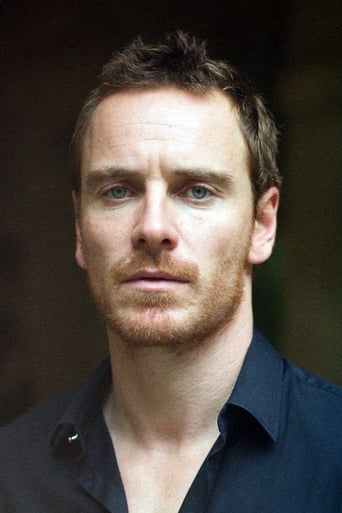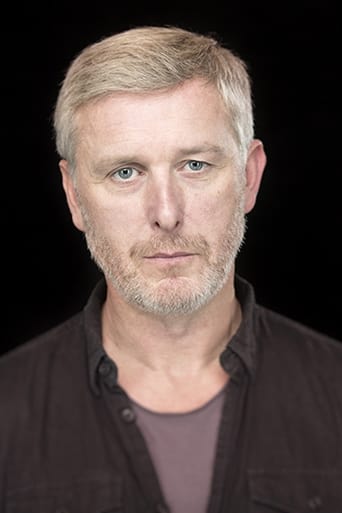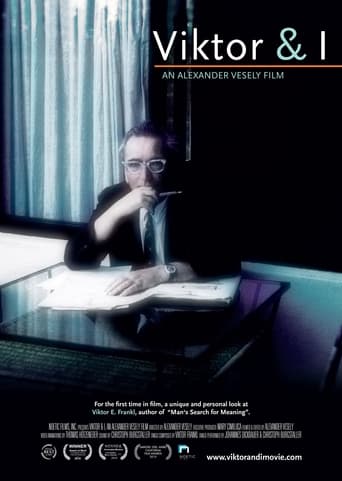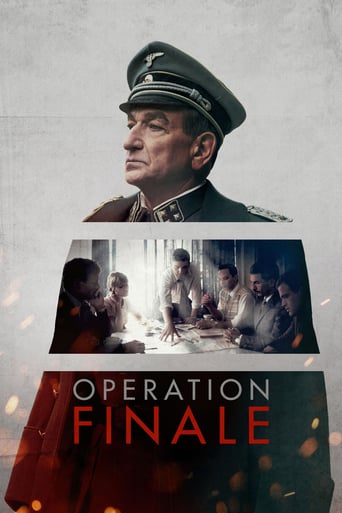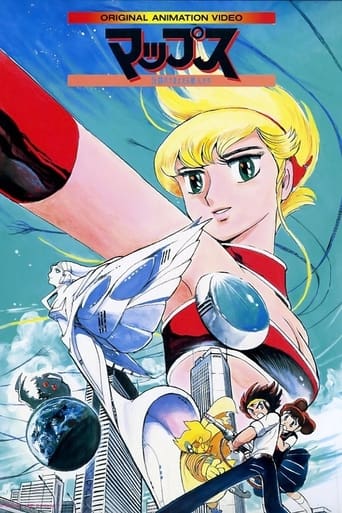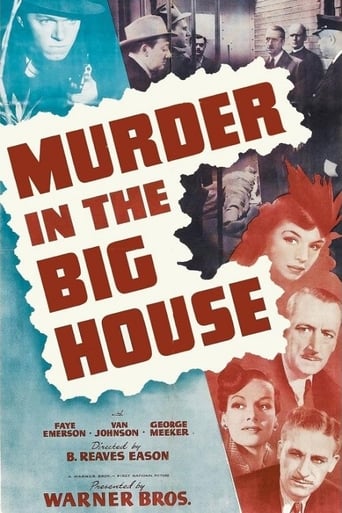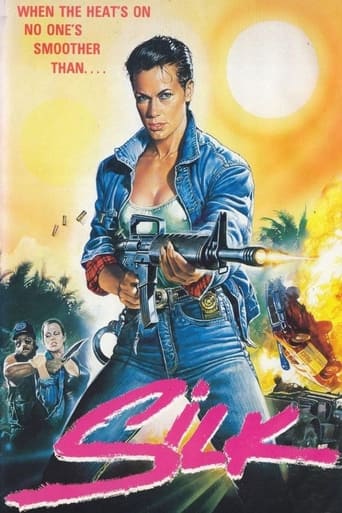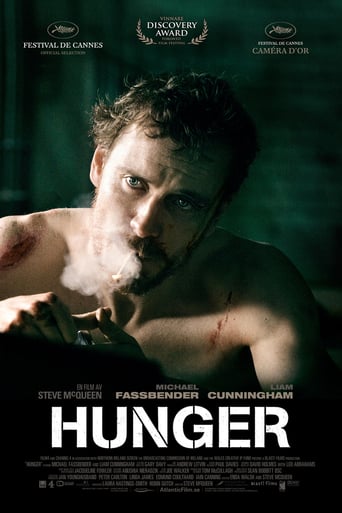
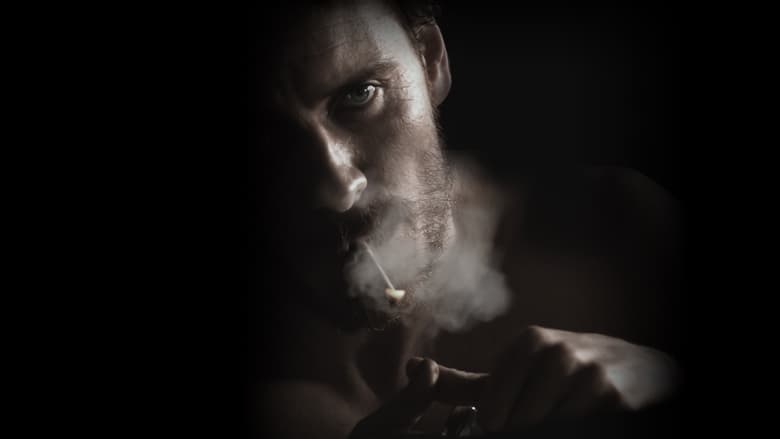
Hunger (2008)
The story of Bobby Sands, the IRA member who led the 1981 hunger strike during The Troubles in which Irish Republican prisoners tried to win political status.
Watch Trailer
Cast


Similar titles
Reviews
I just thought this movie was alright on my first viewing. There were a few aspects I really liked about it such as the middle scene and the depiction of the hunger strike. However, I originally disliked how attention was taken away from most of the characters introduced in the first act. Overall, it feels like an odd choice to introduce multiple characters only to have them leave the film half an hour later, doesn't it? However, after I revisited this movie a couple more times, I loved it to such great of an extent that it's now one of my favorite films of all time.Northern Ireland, 1981. After the government withdraws the political status of all paramilitary prisoners, the inmates of the Maze Prison retaliate by forming a blanket and a no wash protest, ultimately leading to a hunger strike led by one of the inmates, Bobby Sands.This movie is clearly an unconventional film due to the lack of dialogue and the plot structure. One thing I've learned from watching unconventional movies is that while they may have glaring flaws on the surface, the director might have a good reason for making the film that way. For instance, Bela Tarr and Michael Snow had good reasons for drawing out Satantango and Wavelength as much as they did and Stan Brakhage had good reasons for including no sound in most of his films. Sometimes, if I think more about aspects which seem like glaring flaws in unconventional films, it starts to make sense that a director would make their film that way. That was how I warmed up to this film.What I love about this movie is its unique story structure. I initially thought it was a traditional three-act structure. However, I make the argument that the first and the third acts are bookends to the dialogue sequence in the middle. The first act showed the failed protests and the consequences they had on both the guards and the prisoners, the second act showed a prisoner revealing his plans of a more organized protest, and the third act showed that protest in action. By featuring only one prisoner in the third act, I think the statement McQueen is making here is that the hunger strike protest worked better as, since there were less people involved, it was more organized. I initially criticized the movie for taking attention away from several of the characters introduced in the first act, but I now think that this decision helped the film.Another point which McQueen appears to be making here is that both sides are tired of the protest but are unwilling to back down. This is conveyed in numerous places such as how Raymond Lohan can be seen cleaning his bloodied knuckles a couple times in the film. There's also a powerful moment where a prison guard can be seen crying while the rest of the guards beat numerous prisoners with batons. This implication also extends to different prisoners such as Gerry as his emotions convey fright and determination as he smears his faeces on the wall for the protest. These scenes add a layer of humanity to this film.It's also hard not to talk about the number of memorable moments found in the film such as the captivating and well-acted dialogue sequence in the middle which feels like the film's centerpiece. Besides that scene, however, dialogue feels unimportant to absorbing the rest of the film and its characters, so the mostly dialogue free film seems to thrive on this restriction. There's also other chilling moments outside of the dialogue such as when Lohan is killed by an IRA assassin in front of his catatonic mother who seems unaware of her surroundings. Another great scene is the long, stationary, and expressive shot of a prison attendant cleaning up multiple puddles of urine. Finally, it's hard not to mention the painfully realistic depiction of Sands' hunger strike. To film that sequence, Fassbender went on a diet of less than 900 calories for 10 weeks to give the illusion of starvation. This sequence was filled with clever moments such as a montage of Sands' food servings slowly getting smaller as he inched closer to death, images and sounds of flying birds as he convulsed in pain, and what I think was his hallucination near the end of his strike.In conclusion, I think this film is a masterpiece, and it's, currently, my favorite film of the 2000's. It's also one of the best debut films I've seen before. While this film can be hard to watch due to the brutal and disturbing content found throughout, it remains so compelling for a variety of reasons that you can't turn away from the picture. Not for the faint of heart, but a must-see for older viewers.
Hunger shows us Irish Republican Army (IRA) activists, whom prisoners demand to be treated as political prisoners (their goal was to separate Northern Ireland from the UK and re-emigrate to Ireland), receiving inhuman treatment, being humiliated and having to cope with daily violence, led by Bobby Sands (Fassbender), decide to go on a hunger strike to have their orders met. Not deepening in the political aspect of the story, Steve does show the dehumanization suffered by both prisoners and prison guards, beautifully done, with incredible takes, marvelous dialogues, it's a heavy film that is not easy to digest, but it's worth it to be seen. Besides, Fassbender still delivers a performance like Christian Bale in The Machinist (2004), leaving you totally paralyzed.
HUNGER (2007), the first effort by director Steve McQueen, is a dramatization of the 1981 hunger strike carried out by IRA prisoners in Northern Ireland. Seeing themselves as political prisoners, these men demanded to wear their own clothes instead of prison uniforms, have greater visiting rights, and be free from prison work. The most prominent participant in the strike was Bobby Sands, who died after 66 days without food.The film can be divided into three parts. The first presents the prison conditions that the men suffered before the strike. We see this routine through the eyes of two minor prisoners and a guard. Beatings are regular, the prisoners are left naked with only a single blanket to cover themselves with in freezing weather, and for the most part, the prison officials are portrayed as brutal automatons as stripped of their humanity as the Roman soldiers on Gaudi's Sagrada Familia, which makes the pangs of conscience of a couple of them all the more moving. The second part is a hinge in the action. Sands (Michael Fassbender) comes to the forefront, explaining his motives to a priest (Liam Cunningham) in an ambitious 17-minute single shot. Finally, the last third of the film tracks Sands' weakening and death. Sands' deterioration -- he's soon covered with sores and reduced to a skeleton -- is graphic, and one wonders how the filmmakers did it, because it seems to go well beyond mere makeup effects.For someone unfamiliar with the Troubles, the prison conditions were sad and outrageous, as if prisoners were treated like this in the early 1980s, then the West was compromising its values of humanity and justice. HUNGER thus introduced me to a sorry episode in recent history and it's valuable for that. However, I'm uncomfortable with the latter half of the story, which goes beyond the principle that everyone, even the incarcerated, deserves humane treatment. Sands is portrayed not only as a man standing up for better treatment in prison, but as a soldier with wider political goals, a lingering desire to unite Ireland by violence. There's also touches of religious symbolism, Sands as Christ figure, which is too pat and downright offensive considering he was an incarcerated terrorist. Yes, even the message that even criminals deserve fair treatment is a noble one, but you've still got to acknowledge that the man's political designs were heinous.Still, even if the plot is irksome and a couple of shots seem like padding (what's up with the long floor-mopping scene?), there are some fine aspects of the film. The set design is meticulous. Cunningham brings the air of an experienced stage actor into the film, which works surprisingly well. Seeing this film upon its release, I suspected McQueen would progress to great things and I was curious to see his future work.
The Film is like an oratorio fort he death of Bobby Sands in a British prison in Northern Ireland in 1981 after a sixty-six day hunger strike. He was only the first one to die in a series of nine and it took nine lives to be wasted for the British government and Margaret Thatcher to yield on all the demands of the prisoners except the status of political prisoners.The film does not rewrite history and we are supposed to know this most abominable episode of the inglorious war in Northern Ireland. The British had no future there but after this dramatic event the British had lost any moral or political claim in Northern Ireland which was both part of Ireland and not British at all, except as a brutal colony.The film just gives us a believable vision of this horror: the refusal to wear prison uniforms, hence the locking up of the prisoners in absolutely unbearable semi-isolation with nothing to wear but a blanket, thence the refusal to wash and the frightening painting of the cells by the prisoners with their own excrement. Then they had to be taken one by one to be forcefully shaved and washed up in a bathtub with a lot of violence and beating up. The only right they had was that of common criminals: a visit by relatives every so often, or rather every so rarely. Then they accepted to put on a pair of black trousers: the only moment when they were dressed. The hunger strike on March 1, 1981 was the most drastic decision and the film tries to listen to Bobby Sands' arguments when he discusses them with his priest. We have to listen to those of the priest too, essentially that it was vanity that moved them because they were looking for martyrdom and if they died, the priest said, it would only be suicide. And we know what that means in the Catholic Church.Then the visual depiction of Bobby Sands' death is very graphic. The hatred of some of the nurses and auxiliaries was obvious, including their having UDA tattooed on their fingers so that the prisoners could know where they stood and this UDA capital letters were tattooed on the hitting phalanxes of the fist. The violence was not only real but also symbolical. In fact the film contains little dialogue because the objective is to show the humiliation and the violence and nothing else on one hand and the resistance on the other hand. On one hand you had animals of prey torturing their prisoners. On the other hand you had prisoners reduced to be animals and building their dignity in pushing it to the end of the line, to death if necessary and it was necessary for nine of them.An extremely disturbing film showing how low the British fell in this war and they even stooped too low to be able to conquer anything. They just failed and were defeated.Dr Jacques COULARDEAU


